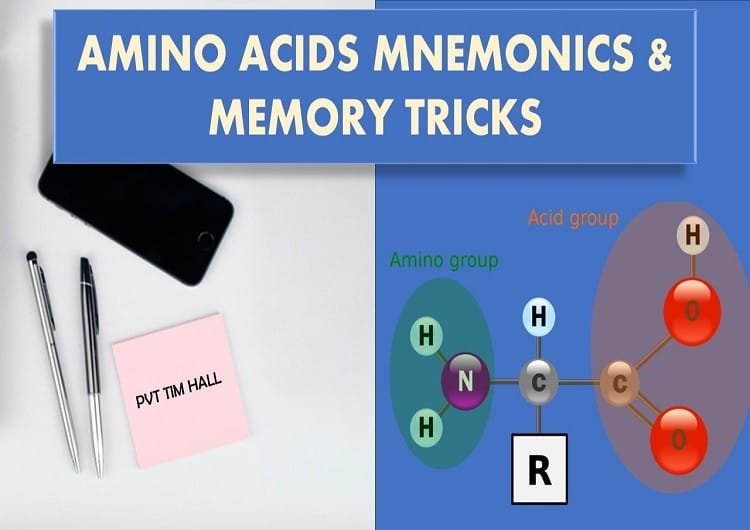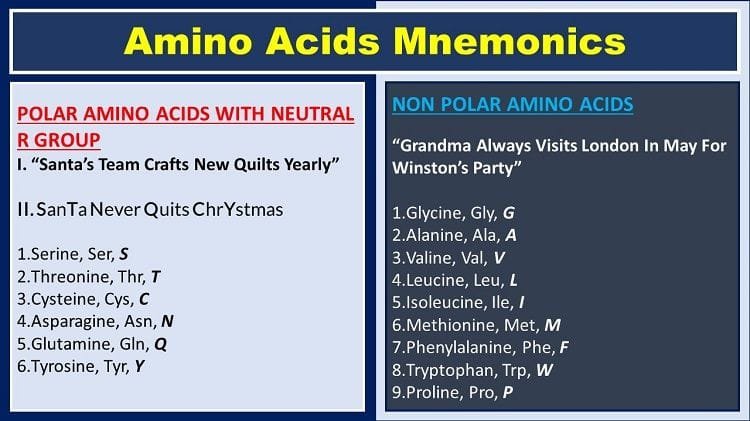How to memorize amino acids? Is there any easy way to remember 20 amino acids? Today’s topic introduces some tricks to remembering all amino acids and their classifications. All about Nonessential and Essential Amino Acids Mnemonic, Polarity of Amino Acids, Ketogenic Amino Acids Mnemonic & Glucogenic Amino Acids Mnemonics.

What are Amino Acids?
Amino acids are defined as the organic compounds that combine to form proteins, the building blocks of life.
Amino acids serve numerous essential functions in the body, such as body growth, breakdown of food particles, repair of body tissues after wounds or injuries, and other metabolic functions. So, an amino acid is an essential source of body energy.
In biochemistry, amino acids are defined as the molecules that are made of an anime group, a carboxylic acid group, and a side chain (which varies in different amino acids).
In simpler form, amino acids are composed of nitrogen, carbon, hydrogen, oxygen, and variable side chain group.
How many amino acids are there?
There are 20 standard amino acids that are either used to synthesize proteins, and other biomolecules or are oxidized to urea and carbon dioxide as a source of energy.
Two additional amino acids are in some species coded for by codons that are usually interpreted as stop codons. These two additional amino acids are Selenocysteine (Sec, U) and Pyrrolysine (Pyl, O).
Types of Amino Acids
Some amino acids are produced in the human body while others can’t be made by the body. Based on this, 20 amino acids are classified into three groups:
- Essential amino acids
- Nonessential amino acids
- Conditionally Essential amino acids
What are Essential Amino Acids?
The amino acids that are not produced by the body and must come from consumed food are known as essential amino acids. The best sources of essential amino acids are animal proteins like eggs, poultry, and meat.
The protein found in consumed food is broken down into amino acids, which are then used to help your body with various processes such as building muscle and regulating immune function.
How Many Essential Amino Acids are there?
The 9 essential amino acids are histidine, isoleucine, leucine, lysine, methionine, phenylalanine, threonine, tryptophan, and valine.
Nonessential Amino Acids
The body produces nonessential amino acids, even if we don’t get them from the food we consume. There are 11 nonessential amino acids. Alanine, arginine, asparagine, aspartic acid, cysteine, glutamic acid, glutamine, glycine, proline, serine, and tyrosine are nonessential amino acids.
Conditionally Essential Amino Acids
Some nonessential amino acids are categorized as conditionally essential because they are essential only under specific circumstances such as illness or stress.
For instance, the nonessential amino acid, arginine must be supplied through diet in cancer disease as the body can’t meet demands. So, it is a conditionally essential amino acid.
Other nonessential amino acids which become conditionally essential amino acids in body illness and stress are cysteine, glutamine, tyrosine, glycine, ornithine, proline, and serine.
Nonessential and Essential Amino Acids Mnemonic
The following memory tricks or mnemonics of nonessential and essential amino acids (AA) will help you to remember 20 AA with their classifications.
First Mnemonic for Essential Amino Acids

PVT TIM HALL
- Phenylalanine
- Valine
- Threonine
- Tryptophan
- Isoleucine
- Methionine
- Histidine (Conditionally Essential Amino Acid)
- Arginine (Conditionally Essential Amino Acid)
- Lysine
- Leucine
The modified mnemonic for PVT TIM HALL is AV HILL MPTT.
Second Mnemonic to remember essential amino acids
Look There, Look There, VIP Man!
- Leucine
- Threonine
- Lysine
- Tryptophan
- Valine
- Isoleucine
- Phenylalanine
- Methionine
Some other amino acids (Histidine, Arginine) are considered to be essential under certain conditions.
Mnemonics for Nonessential Amino Acids
First, use above mentioned mnemonics to remember essential amino acids. The remaining 11 amino acids are nonessential amino acids.
Ketogenic and Glucogenic Amino Acids Mnemonic
Some amino acids can be converted into glucose while others can be converted to ketone bodies. On the basis of the metabolic fate of the amino acids, they are either ketogenic, glucogenic, or both.
- Ketogenic Amino Acids: They can be converted to glucose with the help of the carbon skeleton of amino acids. Lysine and Leucine are ketogenic amino acids.
Ketogenic Amino Acids Mnemonic
Keto LL
- Partially Ketogenic/Glucogenic: Isoleucine and the other 3 aromatic amino acids (Tyrosine, Tryptophan, Phenylalanine) are both glucogenic and ketogenic.
Both Ketogenic and Glucogenic Amino Acids Mnemonic
Iso-Aromatic
- Glucogenic: The rest of the amino acids are able to be converted into glucose with the help of the carbon skeleton of amino acids. Hence, they are glucogenic in nature.
Glucogenic Amino Acids Mnemonic
Memorize other amino acids with the help of the above-mentioned mnemonics, and it will be easy to remember the rest of the amino acids (that are glucogenic).

Polar Amino Acids Mnemonic
On the basis of polarity, amino acids are categorized into 4 groups:
- Polar with neutral R group (Hydrophilic)
STY (Serine, Threonine, Tyrosine), CNQ (Cysteine, Aspargine, Glutamine)
Mnemonic to memorize Polar AA with a neutral R group
STYCNQ
“Santa’s Team Crafts New Quilts Yearly”
- Serine, Ser, S
- Threonine, Thr, T
- Cysteine, Cys, C
- Asparagine, Asn, N
- Glutamine, Gln, Q
- Tyrosine, Tyr, Y
- Polar with +R group (Hydrophilic, Basic)
Arginine, Histidine, Lysine
Mnemonic to remember Polar and Basic AA
Basic HAL
- Polar with -R group (Hydrophilic, Acidic)
Aspartate, Glutamate
- Non-polar (Hydrophobic)
Remaining all (Glycine, Alanine, Valine, Leucine, Isoleucine, Methionine, Phenylalanine, Tryptophan, Proline)
Mnemonic to memorize Non-Polar Amino Acids
– GAVLI MFWP
“Grandma Always Visits London In May For Winston’s Party”
- Glycine, Gly, G
- Alanine, Ala, A
- Valine, Val, V
- Leucine, Leu, L
- Isoleucine, Ile, I
- Methionine, Met, M
- Phenylalanine, Phe, F
- Tryptophan, Trp, W
- Proline, Pro, P
Electrically charged side chains
“Dragons Eat Knights Riding Horses”
- Aspartate, Asp, D
- Glutamate, Glu, E
- Lysine, Lys, K
- Arginine, Arg, R
- Histidine, His, H

One Letter Abbreviation Exceptions AA with Mnemonics
There are some amino acids that do not have the first letter of their names as the abbreviation. These include:
- K = lysine (Remember as ‘Klysine’)
- Y = tyrosine (‘tYrosine)
- D = aspartic acid (‘asparDic acid’)
- Q = glutamine (‘Q-tamine’)
- R = arginine (‘R-ginine’)
- E = glutamic acid (‘glutEmic’ acid’)
- F = phenylalanine (‘Fenylalanine’)
- N = asparagine (‘Nasparagine’)
- W = tryptophan (‘tWyptophan’)
Definition of Mnemonic
A mnemonic or a memory aid is defined as a tool that assists us to remember particular facts or a large quantity of information. Mnemonics are in the form of songs, phrases, sentences, rhymes, acronyms, images, poems, outlines, or other tools.
Mnemonics help us remember facts and important information, and are particularly useful when the order and chronology of things and events are important.
Merriam-Webster Dictionary defines a mnemonic as a technique for improving memory. Mnemonic (pronounced ni-mon-ik) is derived from the Greek phrase mimnēskesthai meaning to “remember.
Most of the mnemonics are acronyms or initialisms which reduce a lengthy set of terms to a single, easy-to-remember word or phrase.
Medical Mnemonics
Mnemonics are extensively used in the field of medicine, biology, and biochemistry. They are handy tools to memorize any important information from anatomy, physiology, biochemistry, pathology to pharmacology.
Medical, nursing, and paramedical students have to do so much of the study-related work in little time. They don’t even get enough time to review for quarterly and board exams. They are forced to memorize a whole lot of information in no time.
In such hard times come medical acronyms and medical mnemonics to relieve the pain of medical students.
Nonessential and essential amino acids mnemonic or memory tricks help students to remember 20 amino acids and classify them in different categories on the basis of their varying side chains.
YOU MAY ALSO LIKE
Beck’s Triad in Cardiology: Mnemonic, Treatment & More
Cushing’s Triad in ICP: Pathophysiology, Mnemonic, & More
Acronym for Cranial Nerves Mnemonic – Dirty, Funny Tricks
Spermatic Cord Contents Mnemonic – Dirty and Funny
Carpal Bones Mnemonic: Wrist Bones Names in Order







